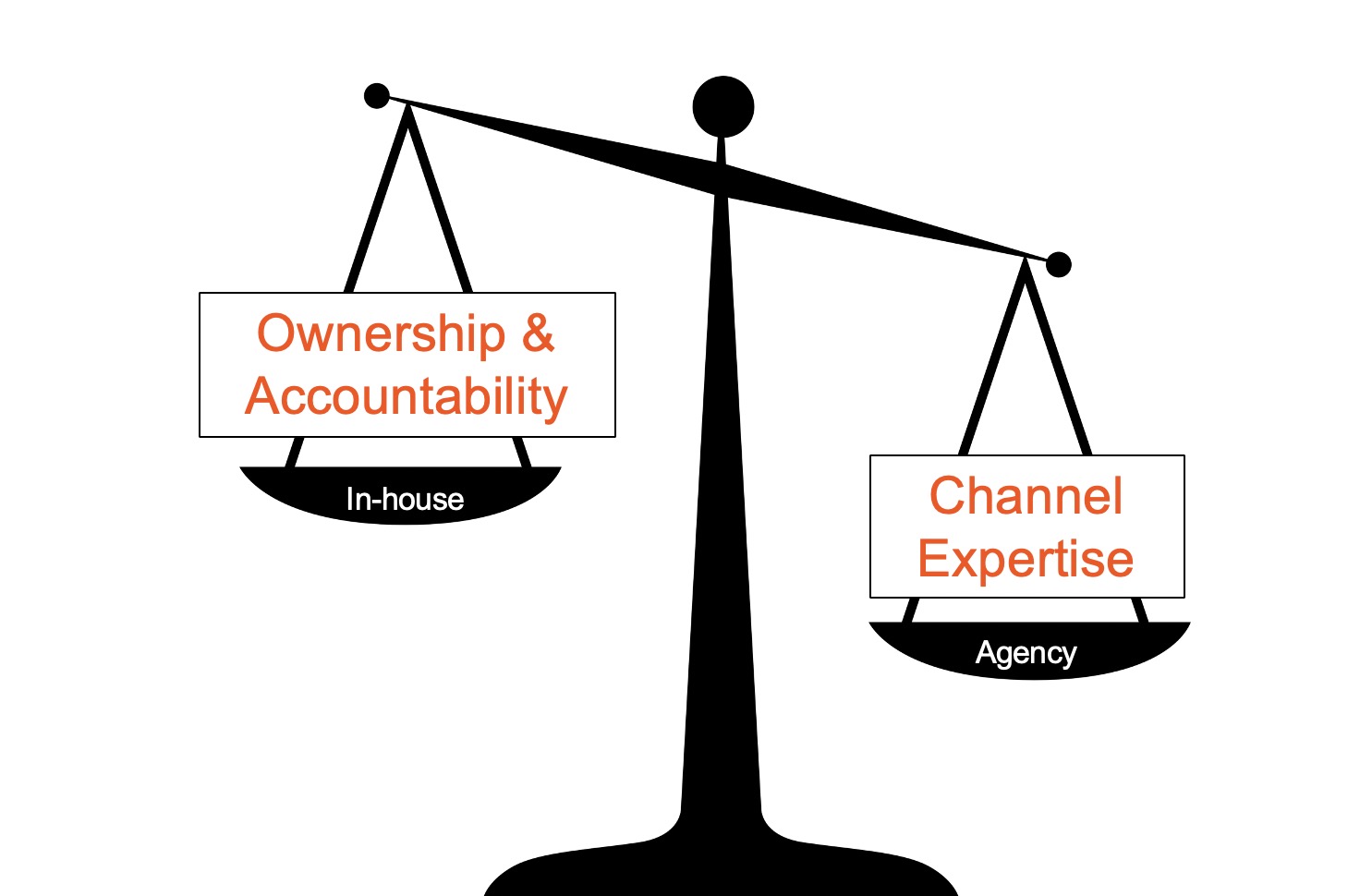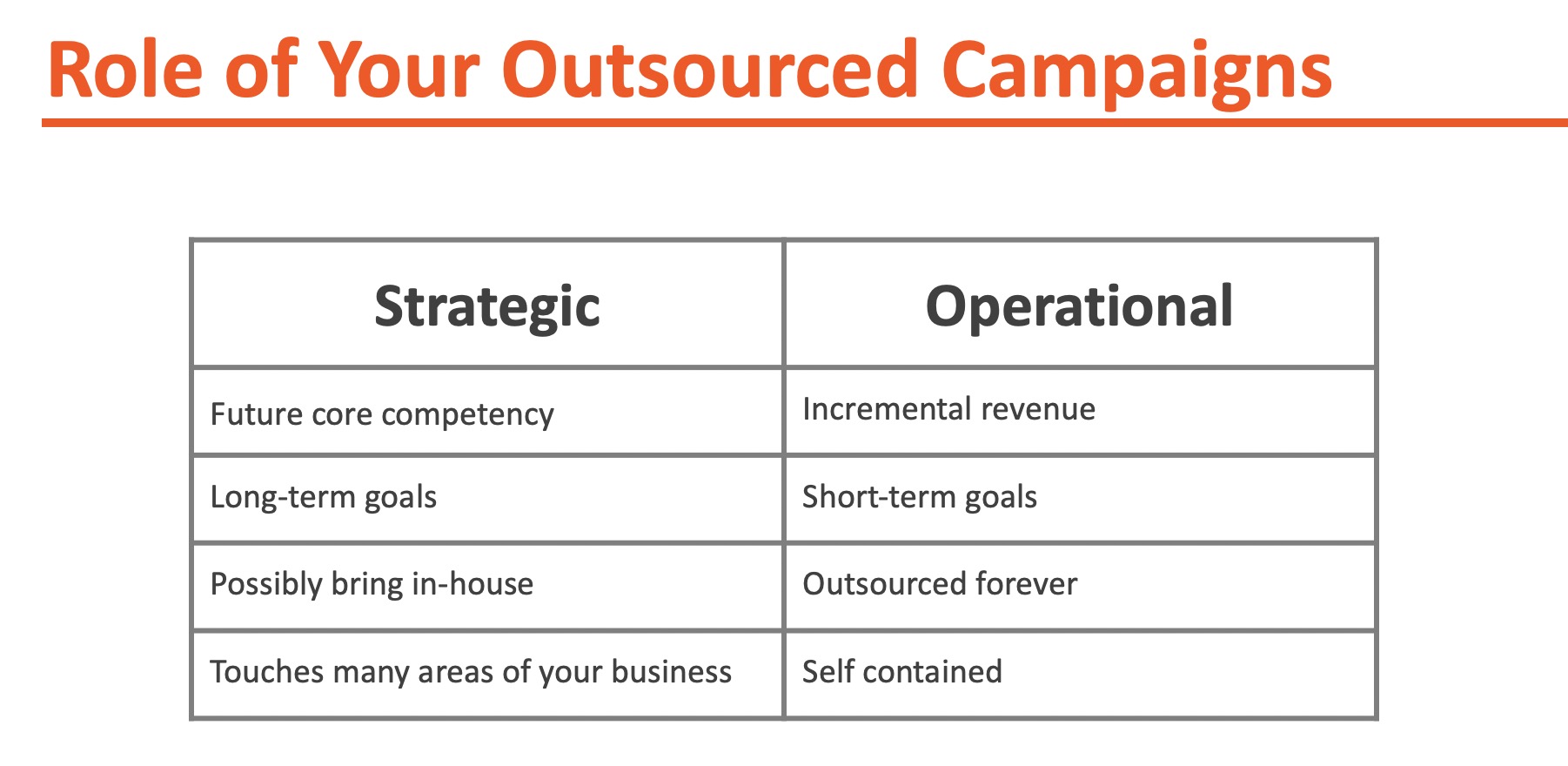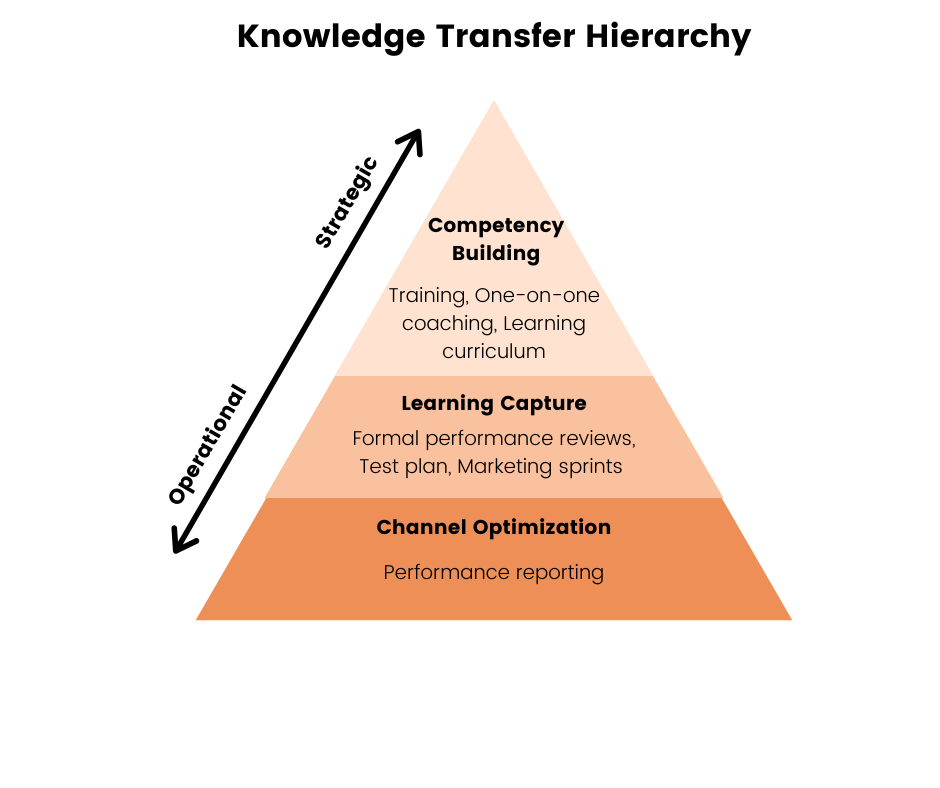Let’s be honest, when you outsource a growth marketing campaign to a digital agency you are making an inherent tradeoff. You are trading the ownership and accountability you’d expect from your in-house team for external channel expertise. The potential downside of this tradeoff is that your campaigns get less attention than they deserve and as a result, performance suffers. Companies of every size wrestle with this issue – from startups to fortune 500 companies.
Hiring in-house gives you more day-to-day control over your campaigns, and allows you to leverage product knowledge that an external team may have difficulty grasping. Despite the advantages of building internal capabilities, managing digital campaigns in-house is often not possible due to resource constraints. For rapidly evolving marketing channels, the expertise you need may not be available from a full-time, internal hire.

These issues pose important questions about how to structure your internal team to effectively manage the agency relationship and capture learnings from your outsourced campaigns. When working with an agency, it can be challenging to extract and internalize learnings that can be leveraged to make product and business decisions.
From my 20 years of experience working on both sides of agency engagements, I’ve found that the key to a productive relationship with your agency is understanding the role digital marketing plays as a value driver within your organization. As you’ll learn in this article, understanding the strategic role of your marketing initiatives dictates how you structure your marketing team and agency relationships.
Digital Marketing as a Strategic Initiative
A strategic digital marketing initiative involves a campaign with potential to become a new core competency of your business. In contrast, an operational initiative is simply a campaign that generates incremental results.

We were hired by a network security software company to generate leads across multiple online channels. To get started, they gave us a target customer acquisition cost and we were off to the races. As long as our campaigns generated leads worth a multiple of our fee, they would be happy.
Our client initiated our engagement to test a couple of digital channels and achieve an incremental increase in their lead volume. For their organization, our digital campaigns were simply an add-on to their primary sales channel. The majority of their sales came from account-based marketing (ABM) efforts targeting the list of Global 2000 companies. For the foreseeable future, ABM would remain their primary sales strategy.
In contrast, we consulted with a mobile app developer who was building a large information website using the vast amount of data generated by their app. They viewed our campaign as a strategic initiative to transition their user acquisition from online advertising to organic search. Their goal, ultimately, was to reduce their advertising spend and generate app downloads from organic traffic.
For the network security client, their competencies in AI software development and sales management were the primary value drivers for their organization. Outsourcing the lead generation campaigns made sense and they had no desire to build in-house capabilities in this area. Also, an overly communicative digital marketing agency would have been a distraction.
However, the mobile app client was a true digital marketing company in the sense that digital marketing was a primary value driver and their competitive advantage. Building their core competency in digital marketing required them to internally capture all of the learnings from the outsourced campaign, apply the learnings across their organization, and eventually develop in-house marketing expertise to run the campaign on their own.
The Best Agencies Help You Learn
If your organization sees digital marketing as a long-term strategic initiative, limit outsourcing to expert agencies who can help you learn. Positive ROI on your campaigns is important, but capturing and internalizing learnings is equally valuable when building a core competency that you may eventually bring in-house. Every agency will promise “results”, but few will commit to documenting their learnings and transferring them to your team.
Agencies love “throw it over the wall” projects. These are hands-off engagements with clients who don’t care to be involved in the ebb and flow of the project. When a campaign is successful, the client doesn’t ask why it worked. When a campaign falls short, the client doesn’t attempt to mine the failure for learnings. They just want to delegate responsibility for the campaigns to an agency so they can worry about other aspects of their business.

Transferring learnings to your internal team requires diligence, transparency, and communication from your agency. You want to work with an agency who takes the time to explain what they did, why they did it, and what they learned.
Transforming the Agency Relationship
Your internal marketing team should own responsibility for customer research, product messaging, goal setting, agency accountability, and coordination within your organization.
You will always know your product and customers better than your digital agency. Even if you hire an agency with relevant industry experience, you are the product experts in the relationship. During the initial phase of the project, you will need to schedule meetings with your agency and the appropriate internal teams to communicate relevant product and market information.
Goal setting should be managed in-house with input from your agency. Set aggressive but attainable goals. Then, seek advice from your agency on how to achieve them. Revise your goals as needed until all parties involved feel that they are both impactful and achievable. Be sure to explicitly include your learning goals as success metrics for your agency’s campaigns.

To realize the full benefits of your agency’s expertise, you need to hold them accountable to the milestones and goals you’ve established. It’s very easy for an engagement to drift off track without regular reporting and frequent realignment meetings. We’ve found it best to identify relevant KPIs, establish milestones, and set up a reporting structure during the project kickoff meeting. Then, set expectations around how learnings should be communicated to your team.
Knowledge Transfer
To transfer learnings from an agency to an in-house team, we’ve adopted a number of different approaches:
Weekly or monthly reporting – This can be a simple weekly or monthly email from your agency to your internal team with the tasks that were completed and what was learned from the observed results. We’ve found a monthly write-up of observations, learnings, and next-steps to be the most useful.
Quarterly account reviews – A more in-depth review of the results that have been achieved during the previous quarter that leads to a start/stop/continue conversation. The agency delivers a presentation that is followed by a retrospective discussion to develop an action plan for the next quarter based on the agency’s observations and recommendations.
Test plan – This is a list of experiments you’d like to run and the learnings you seek from each. For example, this could be testing a new landing page, Facebook audience or link building strategy. Getting on the same page with your agency at this level of detail ensures alignment on your learning goals. The key is to get specific and enumerate all of them up front so you can prioritize and allocate resources. Each test should require as few resources as possible to achieve the learning objectives.
Marketing sprints – In the past, I’ve run teams on two week marketing sprints. The sprints focus our efforts on achieving a single desired outcome in a short period of time. Each sprint starts with defining the task at hand and ends with a retrospective meeting to capture learnings. When working with an agency, this can be a good way to maintain control over prioritization and build a structure for reporting back on learnings.
Formal training – Build training for your internal team into the initial scope of work. This will set the expectation with your agency that they should document tasks and outcomes starting from day-one in anticipation of the training sessions. The goal of the training at the end of the project might be to disseminate learnings or bring campaign management in-house.
One-on-one coaching – There may be a specific individual in your organization that you would like to bring up to speed. Ask your agency if they would be willing to provide coaching. Coaching is a skill that not every agency has. It requires patience and a level of “hand holding” that most agencies avoid.
Learning curriculum – In the past, our agency has provided a learning curriculum to clients who seek to train their in-house staff. This curriculum includes our recommended articles, courses, certifications and other resources.

Have it Your Way
With a little forethought, you can structure your agency relationships to best suit your needs. This requires some consideration of the strategic importance of the outsourced campaigns, the structure of your internal team, and the best approach to capture learnings.
Manage your digital agency with a hands-off approach when your attention is needed elsewhere. If your agency is managing campaigns you are unlikely to bring in-house, there is no need to invest in knowledge transfer.
When your agency’s campaigns represent a strategic initiative to test a channel that could transform into a significant value driver for your organization, you need to kick-off the project by defining learning objectives and a strategy to transfer the learnings to your internal team. Make sure your agency understands that your learning goals are as important as the campaign results. This can be a difficult conversation since many agencies aren’t used to working this way. Choose an agency that will be more patient and communicative to ensure that you fully benefit from the knowledge transfer.

